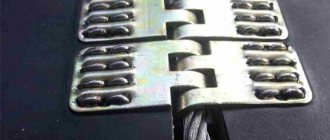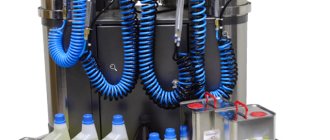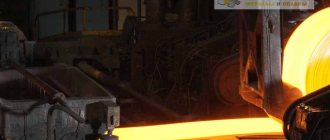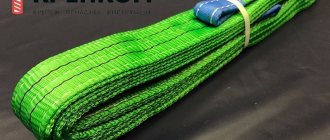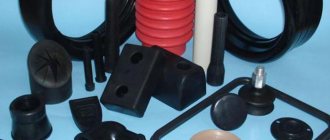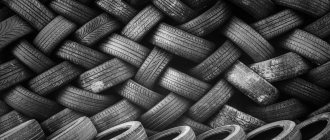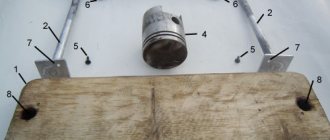Curing
Vulcanization is the name given to one of the technological processes used in rubber production. During this process, raw rubber, whether natural or artificial, becomes rubber.
Rubber that has undergone vulcanization noticeably improves strength, chemical resistance, elasticity, increases resistance to high and low temperatures and a number of other technical properties. The essence of this process is as follows: under the influence of high temperature and a certain pressure, linear macromolecules are bound into a single whole. This system is called vulcanization mesh.
At the end of the vulcanization process, cross-links are created between macromolecules. Their number and structure are determined by the method of carrying out this operation. During this process, certain properties of the rubber do not change linearly, but through certain maximum and minimum points. The point at which the optimal properties of rubber appear is called the vulcanization optimum.
Vulcanization of rubber
To ensure the necessary operational and technical properties of rubber, various substances and materials are added to the rubber - carbon black, chalk, softeners, etc.
In practice, several vulcanization methods are used, but they have one thing in common - processing raw materials with vulcanization sulfur. Some textbooks and regulations state that sulfur compounds can be used as vulcanizing agents, but in fact they can only be considered as such because they contain sulfur. Otherwise, they can affect vulcanization just like other substances that do not contain sulfur compounds.
Some time ago, research was carried out regarding the treatment of rubber with organic compounds and certain substances, for example:
- phosphorus;
- selenium;
- trinitrobenzene and a number of others.
But studies have shown that these substances have no practical value in terms of vulcanization.
Tire vulcanization - description
Vulcanization, from a chemical point of view, is a process in which rubber macromolecules are “stitched” into a three-dimensional spatial network with sparse cross-links. We can also say that this is a technological process of converting plastic rubber into rubber. The ability to quickly and effectively restore is applicable to most rubber industry products. But if inflatable boats, pools and swimming rings need repairs due to lack of use and improper storage, then car tires are repaired much more often. This is due to the heavy loads placed on them.
Tire vulcanization is a modern process that allows you to dramatically reduce the cost of servicing your car wheels in case of damage.
Gone are the days when damaged tires, due to the impossibility of repair, were massively thrown onto the side of the road. The growth in the number of cars has led to a corresponding growth in the auto repair industry, including wheel repair. It is more economical to vulcanize a wheel than to buy a new one.
Tire vulcanization is a modern process that can dramatically reduce the cost of servicing car wheels in case of damage.
At the moment there are 2 technology options:
- hot – rubber is processed at high temperature;
- cold - the damage is restored using a patch attached with a special adhesive.
Hot vulcanization
The process of hot vulcanization of tires is based on heat treatment of the damage site with the addition of rubber (“raw rubber”). Under the influence of high temperature, the rubber components are bonded together, creating a plastic monolithic layer.
Penetrating into the cut site, the heat-treated rubber completely fills the space, preventing dirt and moisture from penetrating into the tire.
Briefly, the hot vulcanization process is as follows:
- The tire is removed from the disk, the cut area is carefully processed with a milling cutter (the main thing is not to damage the cord). The treated area is additionally cleaned and degreased. A special composition is applied to the cut site in 2 layers. The dried damaged area is filled with “raw rubber” layer by layer, after which the tire is sent to a tire vulcanization machine. Heat treatment is carried out at a temperature of 120–140°C. For additional strength, a special cord patch is applied to the inside of the tire. After the rubber has cooled, the repair site is additionally cleaned with a milling cutter and finishing is carried out.
Advantages of hot vulcanization:
- Price. The cost of eliminating side cuts using this method is lower than buying new tires. Reliability. High-quality vulcanization of tires can preserve 90% of the rubber's strength. Efficiency of repairs. You can drive with the repaired wheel immediately after the damage has been repaired. The versatility of the method. Hot vulcanization can be performed at subzero temperatures in winter, as well as in highly dusty conditions. This means that in case of sudden cuts and the absence of a spare tire, you can call a mobile tire service that will repair the wheel right on the road.
Cold vulcanization
Nowadays, using this method is not difficult, since you can purchase a repair kit in every auto or bicycle parts store. The contents of this set may vary, but each one contains patches and special glue.
The repair procedure in this case is similar to the hot method. You also need to treat the damaged surface with an abrasive, remove rubber dust and degrease. After drying, apply glue to the camera and glue the patch. In this case, it is not the duration of the pressure that plays a role, but its strength. Therefore, it will not be enough to simply press down with a stone; more force is required.
Do-it-yourself cold vulcanization of rubber is a fairly simple process that can be performed wherever you are.
Do-it-yourself cold vulcanization of rubber is a fairly simple process that can be performed wherever you are if you have a special kit. However, raw rubber is not made with your own hands at home. For such work you need special equipment.
The main advantages of cold vulcanization of tires:
- Easy to repair. You don't need specialized vulcanizing equipment to repair a cut. All you need is glue, a patch and a degreaser. The ability to quickly eliminate minor punctures and cuts on the road. Low price of vulcanization (even in tire service conditions).
- When repairing by cold vulcanization in a tire shop, it is possible to achieve increased strength of the patch. However, even strict adherence to all technical nuances and the use of high-quality compounds will not provide a 100% guarantee that a hernia will not subsequently occur in the repaired area. Therefore, it is better to leave the restored wheel as a reserve.
- Time limits for cold vulcanizing tires vary depending on ambient temperature, adhesive composition, cut area and rubber thickness. Optimal strength for mobility is achieved in 20–30 minutes. Complete setting occurs in approximately 2 days.
Vulcanization efficiency
Any new tire is definitely better than a refurbished one. Even the smallest through cut violates the integrity of the inner cord layer, which leads to an inevitable loss of rigidity.
Repairing tire side cuts with hot vulcanization (a video of the process can be found online) brings the wheel only 90% closer to its natural strength. This is quite enough for the daily use of repaired tires for 1–2 seasons.
Cold vulcanization using professional adhesives and in a tire shop also gives reliable results. However, if the cord is seriously damaged, this method requires stripping the wheel and installing an additional patch on the inside.
The most common consequence of tire repair is the appearance of a hernia at the site of the repaired damage. They also require urgent removal. If swelling reappears on the side surface of the tire, it is recommended to replace the wheel.
Vulcanization process
The rubber vulcanization process can be divided into cold and hot. The first one can be divided into two types. The first involves the use of sulfur semichloride. The mechanism of vulcanization using this substance looks like this. A workpiece made of natural rubber is placed in the vapor of this substance (S2Cl2) or in its solution, made on the basis of some solvent. The solvent must meet two requirements:
- It should not react with sulfur semichloride.
- It should dissolve the rubber.
As a rule, carbon disulfide, gasoline and a number of others can be used as a solvent. The presence of sulfur semichloride in the liquid prevents the rubber from dissolving. The essence of this process is to saturate the rubber with this chemical.
Charles Goodyear invented the process of vulcanizing rubber
The duration of the vulcanization process with the participation of S2Cl2 ultimately determines the technical characteristics of the finished product, including elasticity and strength.
The vulcanization time in a 2% solution can be several seconds or minutes. If the process takes too long, so-called over-vulcanization may occur, that is, the workpieces lose their plasticity and become very brittle. Experience suggests that with a product thickness of about one millimeter, the vulcanization operation can be carried out in a few seconds.
This vulcanization technology is the optimal solution for processing parts with a thin wall - tubes, gloves, etc. But, in this case, it is necessary to strictly observe the processing modes; otherwise, the top layer of parts can be vulcanized more than the inner layers.
At the end of the vulcanization operation, the resulting parts must be washed with either water or an alkaline solution.
There is a second method of cold vulcanization. Rubber blanks with a thin wall are placed in an atmosphere saturated with SO2. After a certain time, the workpieces are moved into a chamber where H2S (hydrogen sulfide) is pumped. The holding time of workpieces in such chambers is 15 – 25 minutes. This time is sufficient to complete vulcanization. This technology is successfully used for processing glued seams, which gives them high strength.
Special rubbers are processed using synthetic resins; vulcanization using them is no different from that described above.
Practical application of vulcanization
Many of us have known the word “vulcanization” since childhood: we heard it every time we turned to adults for help after puncturing a bicycle tire. Jumping on the repaired bike, we flew off about our children's business, briefly wondering what bike repair had to do with volcanoes. As it turns out, it does!
The word “vulcanization,” as stated in the Encyclopedia, means “the transformation of rubber into rubber.” The process is carried out using the so-called. vulcanizing agents, substances that promote this transformation. Sulfur, metal oxides and other substances together with vulcanization accelerators are used as such agents.
By themselves, rubber, rubber and their mutual transformations are of little concern to anyone except specialists. We are now interested in the practical application of this method. Or rather, one aspect of it: car tire repair.
Hot vulcanization
The technology for such vulcanization is as follows. A certain amount of sulfur and special additives are added to the molded raw rubber. As a rule, the volume of sulfur should be in the range of 5 – 10%; the final figure is determined based on the purpose and hardness of the future part. In addition to sulfur, so-called horn rubber (hard rubber) containing 20–50% sulfur is added. At the next stage, blanks are formed from the resulting material and heated, i.e. curing.
Heating is carried out using various methods. The blanks are placed in metal molds or rolled into fabric. The resulting structures are placed in an oven heated to 130 - 140 degrees Celsius. In order to increase the efficiency of vulcanization, excess pressure can be created in the oven.
After rubber vulcanization
The formed blanks can be placed in an autoclave containing superheated water vapor. Or they are placed in a heated press. In fact, this method is the most common in practice.
The properties of vulcanized rubber depend on many conditions. That is why vulcanization is considered one of the most complex operations used in rubber production. In addition, the quality of the raw material and the method of its pre-processing play an important role. We must not forget about the volume of added sulfur, temperature, duration and method of vulcanization. In the end, the properties of the finished product are also affected by the presence of impurities of various origins. Indeed, the presence of many impurities allows for proper vulcanization.
In recent years, accelerators have been used in the rubber industry. These substances added to the rubber mixture speed up the processes, reduce energy costs, in other words, these additives optimize the processing of the workpiece.
When implementing hot vulcanization in air, the presence of lead oxide is necessary; in addition, the presence of lead salts may be required in combination with organic acids or with compounds that contain acid hydroxides.
The following substances are used as accelerators:
- thiuramid sulfide;
- xanthates;
- Mercaptobenzothiazole.
Vulcanization carried out under the influence of water vapor can be significantly reduced if you use chemicals such as alkalis: Ca(OH)2, MgO, NaOH, KOH, or salts Na2CO3, Na2CS3. In addition, potassium salts will help speed up the processes.
There are also organic accelerators, these are amines, and a whole group of compounds that are not included in any group. For example, these are derivatives of substances such as amines, ammonia and a number of others.
Diphenylguanidine, hexamethylenetetramine and many others are most often used in production. It is not uncommon for zinc oxide to be used to enhance the activity of accelerators.
In addition to additives and accelerators, the environment also plays an important role. For example, the presence of atmospheric air creates unfavorable conditions for vulcanization at standard pressure. In addition to air, carbonic anhydride and nitrogen have a negative effect. Meanwhile, ammonia or hydrogen sulfide have a positive effect on the vulcanization process.
The vulcanization procedure gives rubber new properties and modifies existing ones. In particular, its elasticity improves, etc. The vulcanization process can be controlled by constantly measuring the changing properties. As a rule, the determination of tensile strength and tensile strength is used for this purpose. But these control methods are not accurate and are not used.
Rubber as a product of rubber vulcanization
Technical rubber is a composite material containing up to 20 components that provide various properties of this material. Rubber is produced by vulcanizing rubber. As noted above, during the vulcanization process, macromolecules are formed that ensure the performance properties of rubber, thus ensuring high rubber strength.
The main difference between rubber and many other materials is that it has the ability to undergo elastic deformations, which can occur at different temperatures, ranging from room temperature to much lower ones. Rubber significantly exceeds rubber in a number of characteristics, for example, it is distinguished by elasticity and strength, resistance to temperature changes, exposure to aggressive environments, and much more.
Cement for vulcanization
Cement for vulcanization is used for self-vulcanization operation, it can start from 18 degrees and for hot vulcanization up to 150 degrees. This cement does not contain hydrocarbons. There is also OTR type cement used for application to rough surfaces inside tires, as well as Type Top RAD and PN OTR series adhesives with extended drying time. The use of such cement makes it possible to achieve long service life for retreaded tires used on special construction equipment with high mileage.
Do-it-yourself hot vulcanization technology for tires
To perform hot vulcanization of a tire or tube, you will need a press. The welding reaction between the rubber and the part occurs over a certain period of time. This time depends on the size of the area being repaired. Experience shows that it will take 4 minutes to repair damage 1 mm deep, subject to the specified temperature. That is, to repair a defect 3 mm deep, you will have to spend 12 minutes of pure time. We do not take preparation time into account. Meanwhile, putting the vulcanization device into operation, depending on the model, can take about 1 hour.
The temperature required for hot vulcanization ranges from 140 to 150 degrees Celsius. To achieve this temperature there is no need to use industrial equipment. To repair tires yourself, it is quite acceptable to use household electrical appliances, for example, an iron.
Eliminating defects in a car tire or tube using a vulcanization device is a rather labor-intensive operation. It has many subtleties and details, and therefore we will consider the main stages of repair.
- To provide access to the damage site, the tire must be removed from the wheel.
- Clean the rubber near the damaged area. Its surface should become rough.
- Blow off the treated area using compressed air. The cord that appears outside must be removed; it can be bitten off with wire cutters. Rubber must be treated with a special degreasing compound. Processing must be carried out on both sides, outside and inside.
- On the inside, a pre-prepared patch of size should be placed on the damaged area. Laying begins from the side of the tire bead towards the center.
- From the outside, pieces of raw rubber, cut into pieces of 10–15 mm, must be placed on the damage site; they must first be heated on the stove.
- The laid rubber must be pressed and leveled over the surface of the tire. In this case, it is necessary to ensure that the layer of raw rubber is 3–5 mm higher than the working surface of the chamber.
- After a few minutes, using an angle grinder (angle grinder), it is necessary to remove the layer of applied raw rubber. If the bare surface is loose, that is, there is air in it, all applied rubber must be removed and the operation of applying rubber must be repeated. If there is no air in the repair layer, that is, the surface is smooth and does not contain pores, the part being repaired can be sent under preheated to the temperature indicated above.
- To accurately position the tire on the press, it makes sense to mark the center of the defective area with chalk. To prevent the heated plates from sticking to the rubber, thick paper must be placed between them.
Cold vulcanization
With this method, instead of thermal effects, chemicals are used to activate the butyl layer of the tire. Essentially, in everyday language, cold vulcanization is gluing.
IMPORTANT: the quality of the repair depends on the preliminary preparation of the tire surface. It must be cleaned of dirt and moisture and made rough for better adhesion.
Repairing tires with cold vulcanization does not require bulky equipment; you can use hand tools. Meanwhile, adherence to technology in this case is no less important: any violation of the process will lead to defects. After repair, the tire can be used no earlier than one day later (at a temperature not lower than +20°C).
